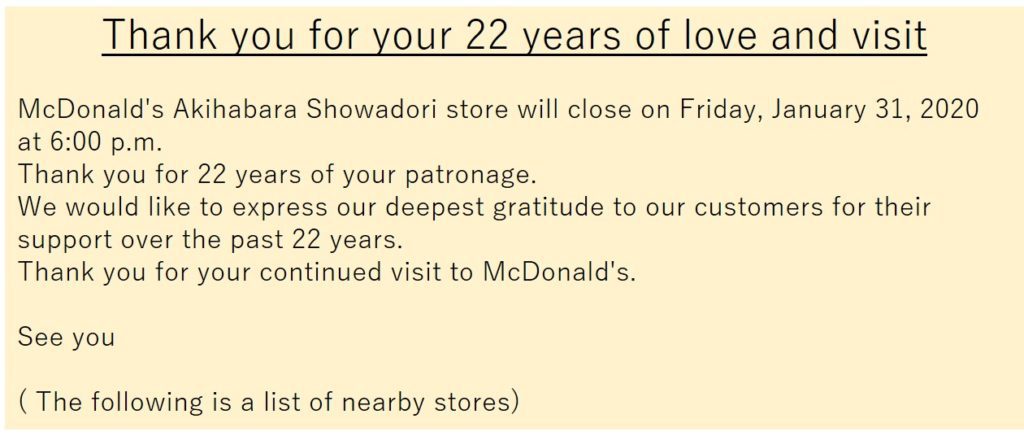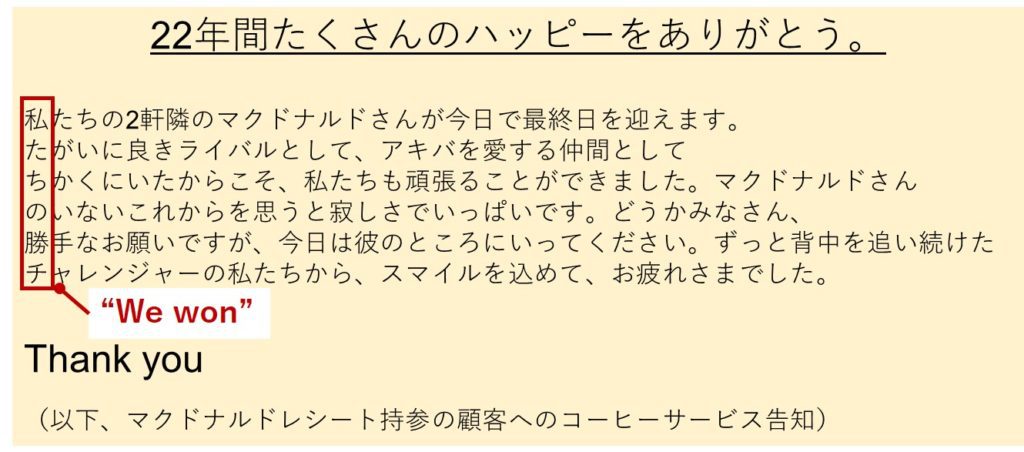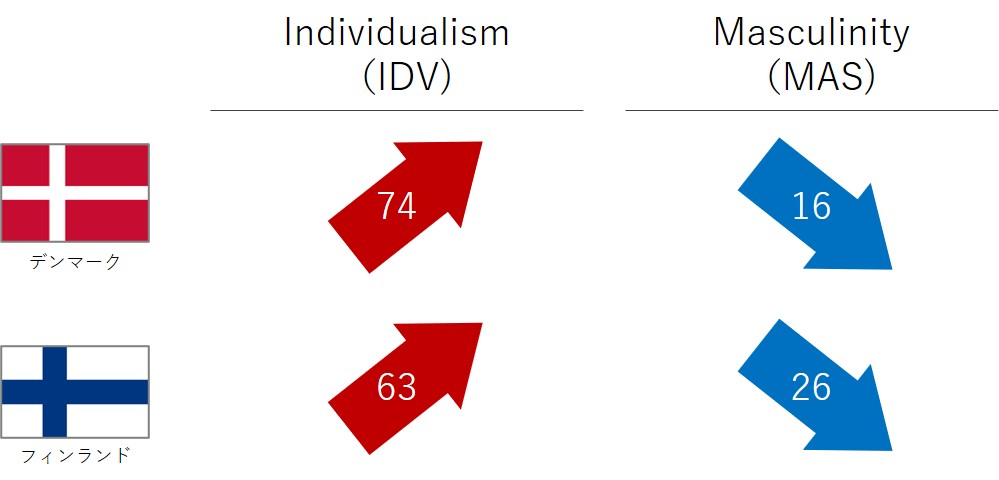BLOGブログ
How Burger King’s Advertising Changes Across Culturally Different Countries?

Burger King comments on McDonald’s closing in Akihabara Japan
The same brand may have different advertisements and promotional expressions in different countries. This is because the national culture has values at its core, and different countries have different mechanisms for attracting customers.
Hofstede Insights has facilitators in 61 countries around the world, and the McDonald’s and Burger King advertisements are often used as examples to illustrate the differences in national culture.
While reading online articles recently, I came across an article about the closing of McDonald’s restaurant in Akihabara in January of this year (2020) and the advertisement that Burger King, located two doors down, had put up in their store regarding the closure of McDonald’s restaurant. (The article is in Japanese)
【感動を返して】閉店する「マクドナルド」に寄せた「バーガーキング」のメッセージが話題にhttps://t.co/bWWTGGilZx
秋葉原昭和通り店での出来事で、「22年間たくさんのハッピーをありがとう」と、一見暖かい内容。しかし、縦読みしてみると「私たちの勝ち」というメッセージが隠されていた。 pic.twitter.com/zLMx2DEwvN
— ライブドアニュース (@livedoornews) January 31, 2020
I thought the Burger King’s advertising style was very Japanese in the light of the Hofstede model. So I’d like to try to figure out its cultural mechanisms.
It’s not always obvious at a glance – Japanese implicit expression
The photo of the ad is as pictured on Twitter in the article above.
The McDonald’s ad on the left is a simple one telling people that the restaurant is closed. It has Donald facing backwards and raising his hand and says “See you”. The text written is as follows

( source: McDonald’s Akihabara Showadori store ad)
In response, Burger King, two doors down, placed an ad in response. That’s the right side of the Twitter photo above. The ad has a similar composition, with a Burger King employee bowing and saying “Thank you”. The text written is as follows.

( source: Burger King Showadori ad)
At first glance, Burger King’s ad is a polite statement about the efforts of a neighboring competitor. It says that customers who bring in their McDonald’s receipts will be offered a cup of coffee, which appears to be within the ordinary scope of a campaign announcement.
However, if you look closely at this Burger King ad, you can see it differently. If you read the words at the beginning of each line VERTICALLY, you will see a statement of “We won” and it looks like a victory message by Burger King. (We can do this vertical reading only in Japanese composition of the ad as you see in below)

( source: Burger King Showadori ad. The underline was added by the autor)
My personal thought after reading this article was “Wow, that sounds like a Japanese cultural expression”. There are two reasons why I thought so. The first one is that the ad is somewhere between easy to understand and hard to understand, and the second one is that it’s very much about winning.
The first one comes from the structure of the message. At first glance, the message is difficult to understand because it is placed in a vertical format. However, if you find it, the meaning is clear and easy to understand because it simply says “We won”.
The second is as the message goes. This ad represents a win over a rival store.
Japanese culture in Burger King Advertising
These two points can be clearly understood in the cultural context of Hofstede’s 6D model of “Individualism” and “Masculinity”.
As shown below, Japan’s Individualism Score (IDV) is 46 and the Masculinity Score (MAS) is 95.
IDV is in the middle and MAS is high, which is where Japanese culture stands.

(Figure 1. IDV and MAS scores in Japan Source: Hofstede Insights)
Individualistic cultures tend to prefer explicit expressions, while collectivist cultures prefer implicit ones. Japan scores a little closer to collectivism, but generally sits between individualism and collectivism. The expression “not clear at first glance, but if you can read it, the message is clear” seems to be exactly the expression of this Japanese ” middle” IDV score.
Also, in a highly masculine culture, there is an emphasis on winning. Japan is a highly masculine culture, and its culture seems to be well reflected in its message of “we won”.
Expression in individualistic culture – The case of Burger King in the UK
At the beginning of this article, I mentioned that there can be clear cultural differences in the presentation of corporate advertising and promotions. What would the same Burger King promotion look like in other countries where the culture is different from Japan?
For example, in the UK, you can see the following ad.
The ad reveals that during the filming of Burger King commercials and promotional material, a McDonald’s Big Mac was always placed behind the Burger King hamburger. The clear size comparison gives viewers a strong impression that Burger King is bigger.
This commercial has a cultural “UK-ness” in it.
Again, let’s compare the UK score of the Hofstede 6D model to the commercial content, as before.

(Figure 2.UK IDV and MAS scores Source. Ibid.)
The above figure shows that UK has a high IDV of 89 and a high MAS of 66.
In other words, UK is an individualistic and highly masculine culture.
Because of the high masculinity, as in Japan, the UK is culturally oriented towards ‘winning and losing’. This can be seen in the message that “Burger King is bigger than McDonald’s”.
At the same time, because the UK is an individualistic culture, the message tends to be clear: the comparison of hamburger sizes in the commercial is clear to anyone who sees it, and the commercial is structured so that every consumer who sees it understands that a Burger King Whopper is bigger than a McDonald’s Big Mac.
Differences between Femininity and Masculinity – The Case of Denmark and Finland
Let’s look at another example of the countries of different cultures. Denmark and Finland are European countries, but culturally they are different from the UK.
Below are the IDV and MAS scores for Denmark and Finland, and although both countries are just as individualistic as the UK, we can see that both countries have lower MAS scores, i.e., they are feminine cultures.

(Figure 3. IDV and MAS scores in Denmark and Finland Source. Ibid.)
This difference in femininity and masculinity can indeed be seen in the Burger King ads in both countries.
Below is a promotion of Burger King in Denmark. Burger King in Denmark took the initiative to politely respond to customer complaints on their competitor McDonald’s social networking site and in the process, conducted a campaign to promote their products inadvertently.
In a highly feminine culture, making claims that “I’m bigger and stronger” tends not to be perceived as a good quality. Therefore, we don’t see direct expressions of victory such as “Burger King is bigger” as in the UK commercial.
Instead, the promotion relates to one of the values of feminine culture: helping those in need. In reality, it doesn’t seem that Burger King is helping McDonald’s, which is in trouble for not being able to reply to complaints. However, the point is that the message structure is not designed to assert superiority over the competitor.
Let’s take another example of a Finnish advertisement. You may find more feminine values here.
The ad, which was put out by Burger King to coincide with the “Gay Pride” event in Helsinki, shows the King of Burger King passionately kissing rival McDonald’s Donald.
In a highly feminine culture, we see the value of inclusion of minorities and seeking harmony. Burger King’s promotion for LGBT events shows that its expressions also go a step further by not being afraid of prejudice.
Because Japan is a highly masculine culture, many Japanese people may feel uncomfortable when they see these advertisements, but I feel that these advertisements clearly express the values of the feminine culture, which is the opposite of the masculine culture.
Global Marketing Requires an Understanding of Cultural Context
In this article, by using Burger King as an example, we have looked at how the influence of different cultures manifests itself in advertising expressions.
Using Hofstede’s 6D model as an aid line of understanding, it becomes easier to see how structural differences in values manifest themselves as differences in advertising representation.
As you get used to this model, when you see an expression, whether it’s a text, an illustration or a video, the moment you see it, you’ll be able to get a sense of the structure of the values that are assumed behind it. Also, when you express something yourself, you will be able to rearrange and rewrite it to fit to the structure of the values you’re targeting.
This kind of perspective will definitely benefit you when you work in global marketing. If you get a chance to look at international advertising and promotional expressions, why not stop and consider the cultural structure behind them?

Yasushi Watanabe
Managing Director
Senior Facilitator
As a managing director of Hofstede Insights Japan (HIJ), he has been dealing with various global transformation projects. Prior to join HIJ, he worked in BCG Tokyo office as a project leader specializing in marketing, corporate strategy, and organization development. He also worked for Sony (Japan / Europe). His current interest is in how to transform organizations in the time of expanding global diversity. He is also a doctoral student at the Graduate School of Human and Environmental Studies, Kyoto University.



